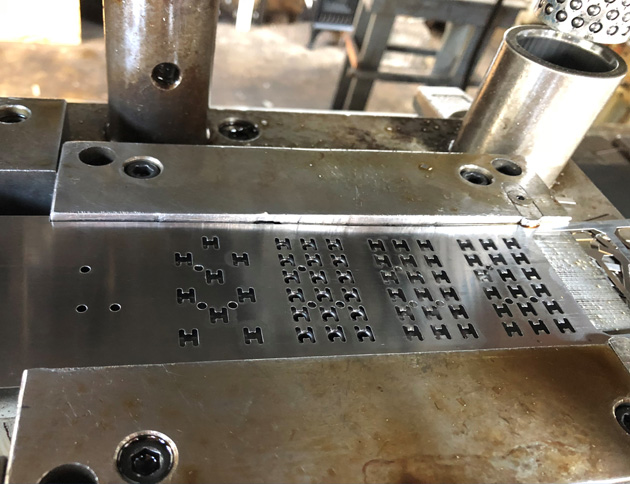The Role of Metal Stamping in Modern Production and Product Advancement
The Role of Metal Stamping in Modern Production and Product Advancement
Blog Article
The Development of Metal Stamping Procedures: Innovations and Applications
The realm of metal marking processes has actually witnessed a transformative trip noted by constant innovation and adaptation to meet the needs of modern industrial practices. From the traditional approaches deeply rooted in history to the advanced innovations driving high-speed accuracy, the advancement of metal stamping has been absolutely nothing except amazing. As brand-new tooling methods and automation discover their means into this market, the ramifications for efficiency and high quality are profound. The applications span throughout a spectrum of sectors, each profiting uniquely from the improvements in steel stamping procedures.
Traditional Metal Marking Methods
Traditional steel marking methods have long been the structure of producing procedures in different sectors due to their performance and precision. The procedure entails developing a metal sheet or coil right into a desired shape by pushing it in between a die and a punch. This technique is widely made use of for creating huge amounts of get rid of high accuracy at a rapid pace.
One of the vital advantages of standard metal marking strategies is the capacity to keep tight resistances, making certain that each part satisfies the required requirements regularly. This degree of accuracy is crucial in industries such as vehicle, aerospace, and electronic devices, where also minor discrepancies can cause substantial concerns.
In addition, conventional steel marking strategies offer cost-efficient options for mass production contrasted to various other making methods. The capability to mark parts in quick succession lessens manufacturing time and decreases labor prices, making it an appealing choice for companies aiming to optimize their manufacturing processes.
Appearance of High-Speed Stamping

Among the essential advantages of high-speed marking is its capacity to keep accuracy and uniformity even at increased handling speeds. This precision is important in markets where tight tolerances and elaborate styles are required. Additionally, high-speed stamping enables the handling of a variety of materials, consisting of aluminum, stainless-steel, and copper, additional increasing its applicability across numerous sectors.
Moreover, the development of high-speed marking has actually enabled suppliers to fulfill the expanding demand for complicated elements in markets such as automotive, aerospace, and electronic devices (Metal Stamping). By leveraging the rate and precision of high-speed stamping innovation, firms can boost their competition in a rapidly advancing market landscape
Developments in Tooling Modern Technology
With the evolution of high-speed marking allowing improved accuracy and effectiveness in steel developing processes, the field of steel stamping has actually seen official statement substantial advancements in tooling technology. Tooling modern technology plays an important function in metal stamping procedures, influencing elements such as item top quality, production rate, and general cost-effectiveness. One essential innovation in tooling technology is the advancement of smart tooling systems that incorporate sensors and checking devices to supply real-time information on the stamping process. These systems can spot issues such as device wear or imbalance, enabling prompt modifications to keep optimum efficiency.
By using these sophisticated materials, tooling producers can generate passes away and mold and mildews that endure the high stress and temperature levels involved in metal marking procedures, resulting in longer tool life and enhanced production efficiency. On the whole, these developments in tooling innovation have actually changed the metal marking market, permitting suppliers to attain higher levels of precision, productivity, and expense savings.
Integration of Automation in Marking
As automation continues to reshape the landscape of steel marking procedures, the assimilation of automated systems has actually become increasingly prevalent in contemporary manufacturing facilities. Automated systems offer countless advantages in metal marking, consisting of boosted efficiency, enhanced accuracy, and enhanced safety and security. By incorporating automation right into stamping procedures, producers can reduce cycle times, decrease product waste, and maximize manufacturing throughput.
One of the essential parts of automation in marking is using robotic arms for jobs such as product handling, component manipulation, and top quality inspection (Metal Stamping). These robotic systems can do recurring and labor-intensive tasks with speed and accuracy, freeing up human operators to focus on even more complex procedures. Additionally, automation permits real-time monitoring and modification of stamping processes, causing greater general process control and high quality guarantee
Furthermore, the integration of automation in marking enables manufacturers to attain regular component top quality, meet limited resistances, and enhance total performance. As innovation remains to advancement, the role of automation in metal marking procedures is expected to view publisher site broaden even more, driving innovation and performance in the manufacturing industry.
Applications Across Diverse Industries
Including metal stamping procedures throughout varied industries showcases the versatility and versatility of this production method. From automotive to aerospace, electronic devices to medical gadgets, metal stamping plays a vital function in the production of a variety of elements. In the automotive sector, steel stamping is utilized to produce detailed components such as body panels, framework parts, and engine get rid of high accuracy and effectiveness. The aerospace sector depends on metal stamping for manufacturing lightweight yet resilient parts for aircraft and spacecraft. In the electronics industry, metal marking is necessary for creating ports, contacts, and various other tiny get rid of limited tolerances. Medical gadget producers use metal stamping for producing precise parts like medical tools and implants. Additionally, the appliance sector benefits from steel marking processes to produce components for refrigerators, washing equipments, and other family appliances. The adaptability of steel stamping processes makes it an important manufacturing strategy across various industries, demonstrating its value in modern-day manufacturing procedures.
Verdict

Report this page